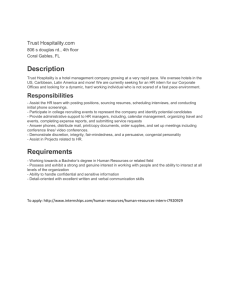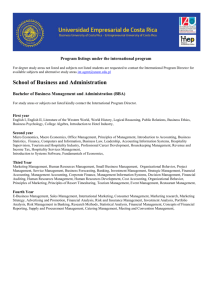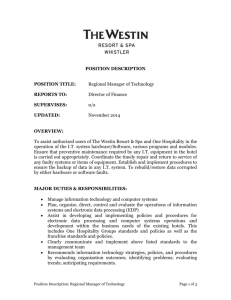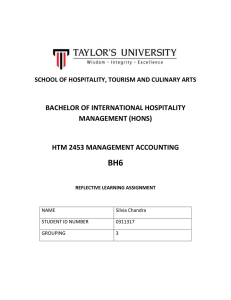One of the major aspects of marketing for hospitality enterprise are
advertisement
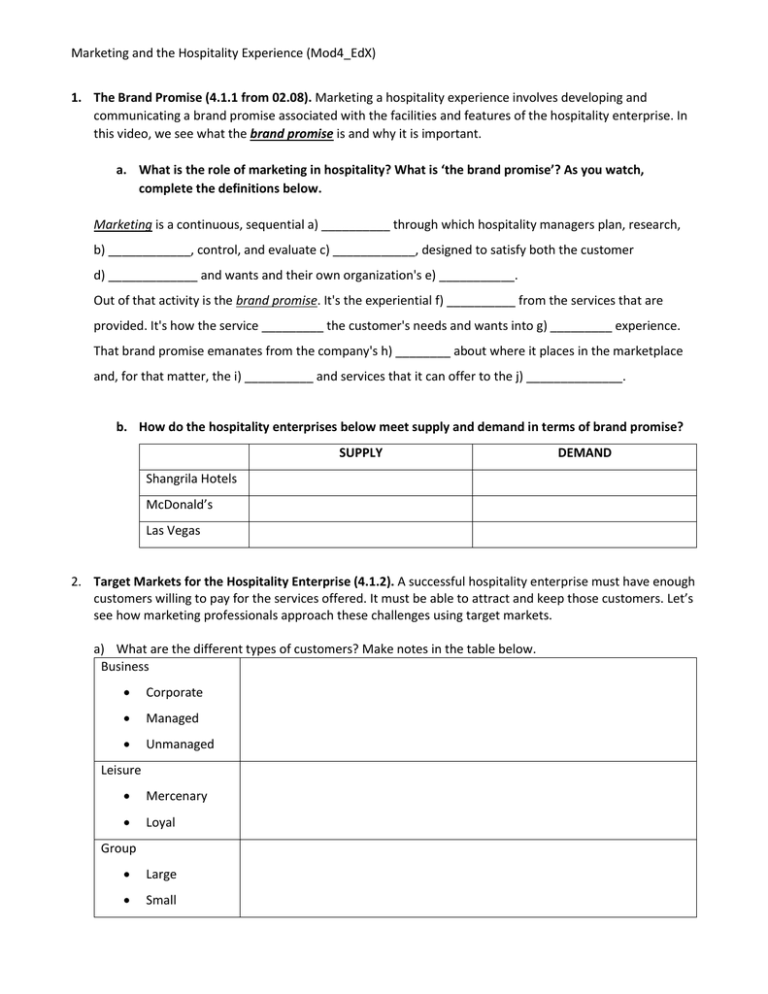
Marketing and the Hospitality Experience (Mod4_EdX) 1. The Brand Promise (4.1.1 from 02.08). Marketing a hospitality experience involves developing and communicating a brand promise associated with the facilities and features of the hospitality enterprise. In this video, we see what the brand promise is and why it is important. a. What is the role of marketing in hospitality? What is ‘the brand promise’? As you watch, complete the definitions below. Marketing is a continuous, sequential a) __________ through which hospitality managers plan, research, b) ____________, control, and evaluate c) ____________, designed to satisfy both the customer d) _____________ and wants and their own organization's e) ___________. Out of that activity is the brand promise. It's the experiential f) __________ from the services that are provided. It's how the service _________ the customer's needs and wants into g) _________ experience. That brand promise emanates from the company's h) ________ about where it places in the marketplace and, for that matter, the i) __________ and services that it can offer to the j) ______________. b. How do the hospitality enterprises below meet supply and demand in terms of brand promise? SUPPLY DEMAND Shangrila Hotels McDonald’s Las Vegas 2. Target Markets for the Hospitality Enterprise (4.1.2). A successful hospitality enterprise must have enough customers willing to pay for the services offered. It must be able to attract and keep those customers. Let’s see how marketing professionals approach these challenges using target markets. a) What are the different types of customers? Make notes in the table below. Business Corporate Managed Unmanaged Leisure Mercenary Loyal Group Large Small Marketing and the Hospitality Experience (Mod4_EdX) b) (from 02.36) What are psychographic characteristics? Why are they important? c) Complete the table below with examples for each characteristic. Activities Interests Opinions W Hotels: http://www.starwoodhotels.com/whotels/about/index.html?language=en_US http://en.wikipedia.org/wiki/W_Hotels 3. Distribution Channels (4.3.1). Consumers engage with service suppliers through various channels, both in person and online. Sometimes channels of distribution involve more than just the customer and the vendor; they involve intermediaries. Let’s explore the role of distribution channels and intermediaries in the hospitality industry. a) Complete the notes below on different marketing channels. One of the major aspects of marketing for hospitality enterprise are the channels through which the customer engages with the service suppliers. They're called the channels of ______________. Formally it's the mechanism by which the customer gets to the supplier or the supplier reaches out to the customer. There are two basic types of channels, _________ to the supplier or through an __________. b) Who are the intermediaries in hospitality typically associated with hotels and cruises? Make notes below. (up to 02.07) 1) Brick and mortar, entity, where we speak with an individual about travel. 2) TUI, Thomas Cook, in Europe are examples. They put together comprehensive ___________ which include air, car, hotel, other destination services into a single package sold to the _____________ or corporate travel departments. 3) Entities which sit behind a complicated process of managing a travel experience. They facilitate the booking of _________ and cars and hotels. If you are putting together a whole passenger name, set of records, and allow the booking of __________ and the changing of those, and the management of those, __________ payments and the like. 4) Could be internal to the organization itself, someone's assistant putting together a __________ or a meeting, a company who has a whole organization devoted to just meeting _________, or it could be private organizations who operate and __________ those activities for companies. c) Watch the rest of the video. Do you agree? Does the same apply in your country / area? Marketing and the Hospitality Experience (Mod4_EdX) 4. Ask the Expert about eCommerce in Hospitality (4.3.2). In this video, Professor Carroll talks with Kathy Misunas, Principal at Essential Ideas. Kathy was formerly President and Chief Executive Officer of the Sabre Group (a division of AMR Corporation) and Chief Information Officer of American Airlines, Inc. She offers her views on what has had the greatest impact on hospitality distribution in recent years and big changes we might see in the years going forward. a. Complete Kathy’s answers below. Before you watch, try to answer the questions yourself. What have been the major changes in hospitality distribution? What are major distribution possibilities for the future? Are there any differences geographically in terms of distribution, changes or trends? What are the different challenges faced by independent companies and chains? 5. On Line Opportunities and Threats (4.4). The Internet has revolutionized hospitality distribution. Professor Bill Carroll explains what this means for hospitality marketing in the following video. a. Hospitality New Media Marketing (4.4.1). What are the main differences between the ‘sales funnel’ of the past and present? Identify and define the stages of the present. PAST PRESENT Acquire Engage Convert Retain b. What are the devices mentioned? ______________________________________________ 6. New Media Challenges (4.4.2). Search engine optimization and reputation management are just two of the challenges facing today's marketing professional. In this video, Professor Bill Carroll discusses these issues as they pertain to the hospitality industry. a. What are the challenges of marketing using new media? Identify and illustrate each challenge. CHALLENGES Marketing and the Hospitality Experience (Mod4_EdX) 7. Measures of Marketing Performance (4.5.2). Hospitality managers can measure marketing performance in a variety of ways. The ideal measure of marketing performance may be return on investment, but marketers may have difficulty calculating that. Are there other measures? Complete the notes below. marketing is part of driving ____________ for a hospitality enterprise. And the owner of those enterprises expects a _____________. the ideal measure is a return on _________________ for marketing activities, sometimes called ROI, return on investment which can be expressed as a number or a ___________. ideally, it's the ___________ revenue less the incremental ________________ associated with business which is driven to the enterprise by marketing activity. Capturing a return on investment is not so easy in the hospitality space because it's hard to __________ how the customer made the _____________ of a particular service provider An example of the complexity of attribution: buying a particular ________ in a search engine in order to ________________ on a search engine's result page when a particular word or phrase is _______________. Google provides __________, which allows an analyzer of marketing activity to ___________ over a period of time the variety of websites that a _______ may have searched before they came to your _________ website. it's possible to do things like ________________ what percent of the time a customer _______________ on your particular keyword, when that came into your ___________ center, or when that came into your brand ______________ and ultimately was _________ into a transaction. Activities associated with social media eg. TripAdvisor reviews, which is a _______-to-peer review, lead to a return on __________________, that is, efforts to measure the level of engagement that the consumer has with the _________________. rate of engagement is how _________ are we at gaining ___________ and engagement of customers. Practically it is an effort to ____________ the level of engagement, who are the customers, and what are those engaging with the enterprise __________ with regard to brand ________ and brand ___________? There is an entire industry _____________ to helping firms do a better job of _________________ their return on investment and engagement which are focused on both social media and ____________.

